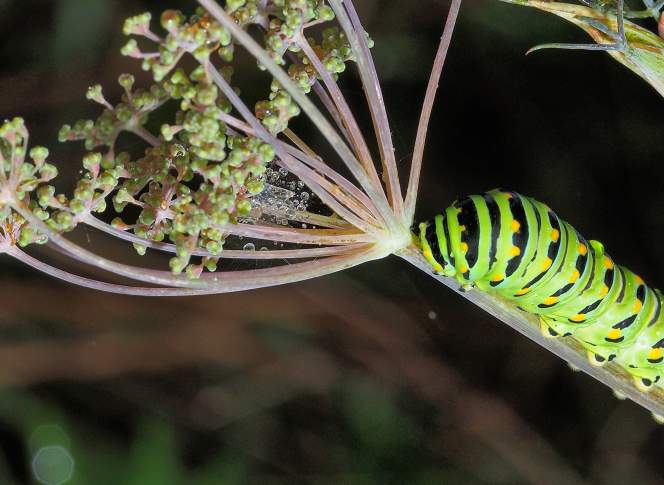The Value Of Letting Nature Take The Lead In Gardens
Whether a meadow of flowering bulbs or a mix of grasses and herbaceous perennials, more varied green spaces provide aesthetic value and habitat for diverse animal communities.
By Will Cushman
April 22, 2019

Black swallowtail caterpillar on bronze fennel flower

Manicured turf lawns obscure an important reality within their uniform foliage: they’re actually quite sterile environments.
“When you mow something to two to three inches tall, there’s a very low level of biodiversity that can be supported in it,” said Ben Futa, director of Allen Centennial Garden on the University of Wisconsin-Madison campus. He was discussing the practice of ecological gardening in a Feb. 13, 2016 talk at the Wisconsin Garden Expo, recorded for Wisconsin Public Television’s University Place.
As a horticulturist, Futa explained he is not a fan of the grassy lawn monocultures that are ubiquitous in American cities and towns.
“Personally, I am an advocate for phasing out the lawn, or looking at alternative lawns, simply because they’re such a relatively sterile landscape,” he said.
Instead, Futa encouraged homeowners to imagine a new look for their yards — uses that provide ecological benefits. Whether a meadow of flowering bulbs or a mix of grasses and herbaceous perennials, more varied green spaces provide aesthetic value and habitat for diverse animal communities, he said.
This relationship between aesthetically pleasing arrangements of plants — both native and non-native — and the animal species they support is the crux of what Futa called “ecological gardening.” It’s an approach to gardening that recognizes not only the connection between rich habitat and biodiversity, but also a backyard’s connection to the built and natural environments that surround it.
“This involves recognizing and harnessing natural systems and synergies in garden design and maintenance,” Futa said.
Rather than attempting to tame nature, he advised gardeners to learn about the natural systems and processes that support thriving wildlife and to tailor their horticultural efforts to mimic or take advantage of those processes. Doing so can provide rich aesthetic and conservation rewards while diminishing the need for weed and pest management, he added.
Futa offered bronze (or sweet) fennel (Foeniculum vulgare) as an example. The herb’s foliage and flowers are attractive to many gardeners, and it has culinary uses. Fennel also provides critical habitat for the caterpillars of swallowtail butterflies, and its flowers attract wasps that feed on common garden pests like aphids.
Bronze fennel is just one of many native and non-native plants that can build ecological resilience in urban landscapes, Futa said, which he said should involve more than simply preserving or restoring natural environments from the past.
“We can no longer necessarily say we must restore environments [or] we must conserve environments,” Futa said. “Because we’ve [already] transformed our environments so dramatically.”
Key facts
- Ecological gardening emphasizes relationships between species in the natural world and leveraging those links to create aesthetically pleasing natural environments that host thriving communities of plants and animals.
- Lawns that incorporate several plant species are linked with greater diversity and density of pollinators than turfgrass lawns.
- Leaving perennials and other plants in place over the winter, rather than cutting or pulling them — can help shade the soil surface and reduce spring weeds.
- Creating a water feature — even one as small as a few feet in diameter — with a gentle gradient that forms a shallow area can benefit many plant and animal species beneficial to a garden, including filter plants and frogs.
- Bronze fennel is an edible herb whose seeds are used in cooking. It’s also a durable perennial with deep tap roots and one of the main host plants for the larvae of swallowtail butterflies. The plants are often covered in swallowtail caterpillars during midsummer. The plant’s flowers also attract insect predators like parasitic wasps, which feed on garden pests like aphids.

Key quotes
- On approaching gardening with a mindset that appreciates the beauty of natural processes: “If we can learn to embrace this beauty of decay and death and embrace it as a natural course of life, it opens a whole new world for us in the garden.”
- On creating garden habitat for wildlife like snakes, rabbits and field mice: “[W]e might kind of cringe and go, ‘Oh, I don’t want to see that in the garden,’ but the reality is having those creatures in the garden is a sign of a very healthy landscape.”
- On the benefit of creating habitat in a garden for beneficial species like toads: “What we realized later in the season [is] is we didn’t have a single bite of slug damage on any plant in the garden, and no pesticides or chemicals were put down. But what we did find was every time we moved a pile of leaves, every time we picked up a hose, there were three or four little toads hanging under there because they had a place to breed and spawn in the spring, and then they found homes throughout the entire garden. … Toads’ and frogs’ favorite food? Slugs.”
- On how the use of bark mulch can affect natural processes in a garden: “Bark mulch inhibits water percolation, it inhibits gas exchange. Yes, it does eventually break down and feed our soil with compost, but … it changes our pH a little bit.”
- On how ecological gardens like the High Line in New York may look wild but are actually tamed spaces: “They’re very manicured, very maintained. They don’t look it, but they’re very intentional and very purposeful. But they were inspired by what was there first. They took cues from what nature was telling them would work well, and that’s what they put there.”
 Passport
Passport











Follow Us